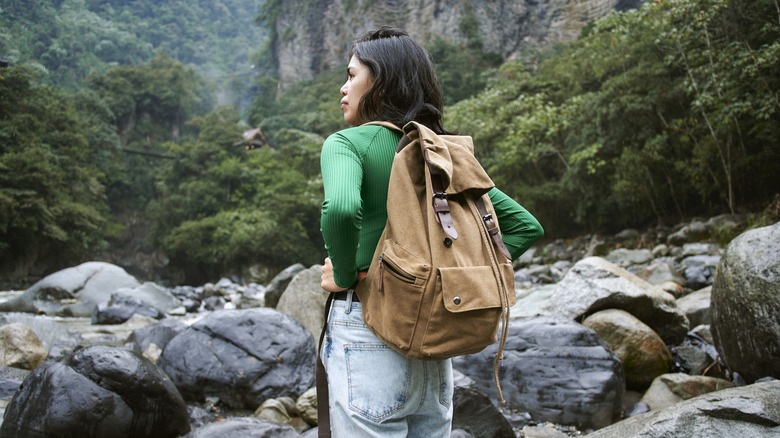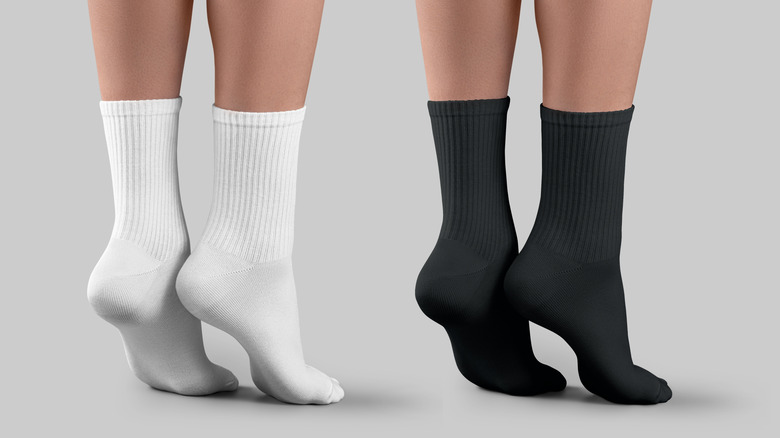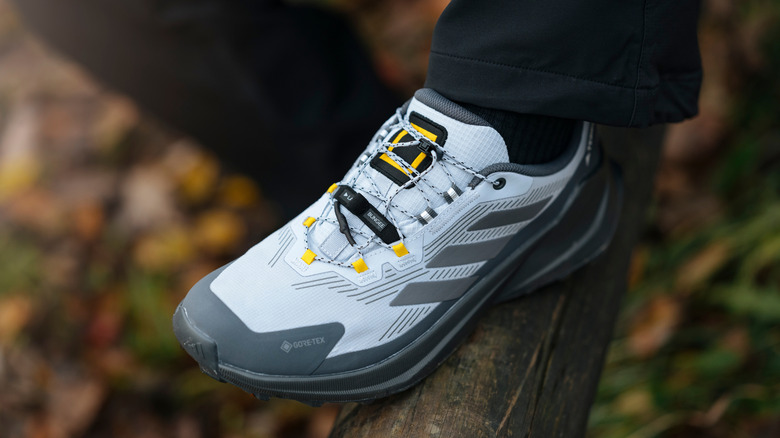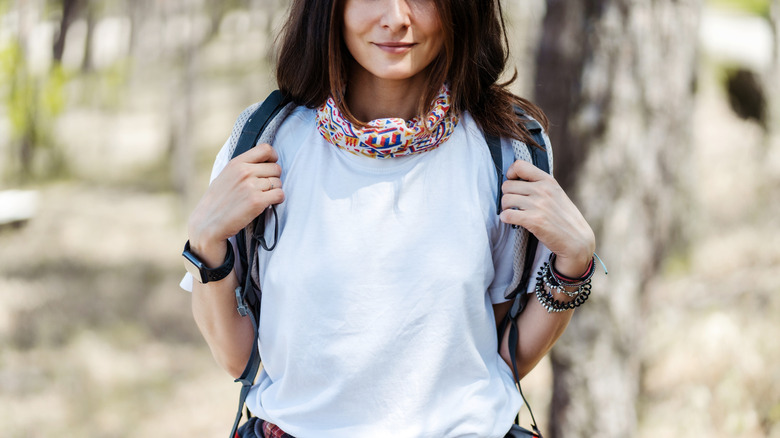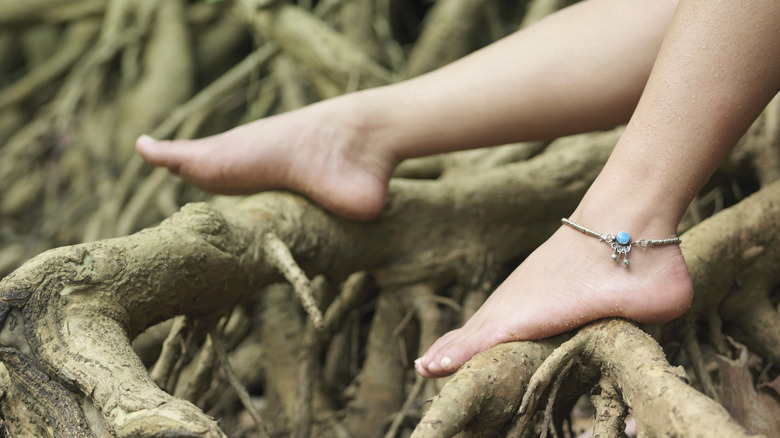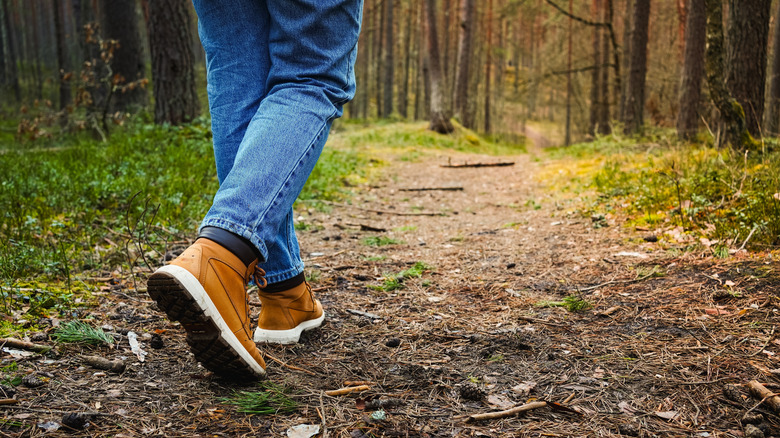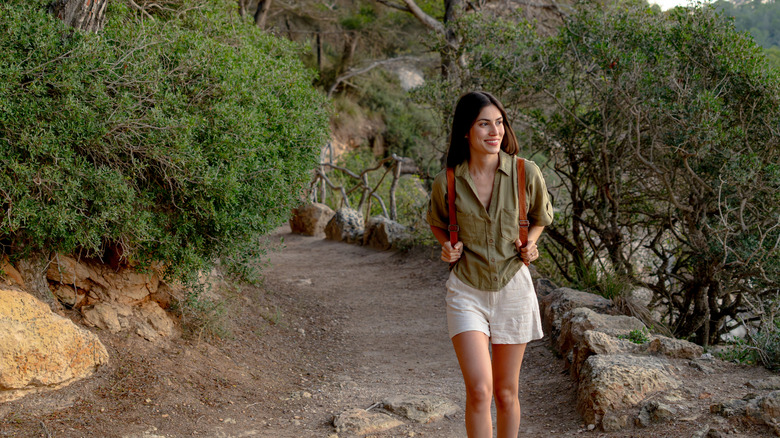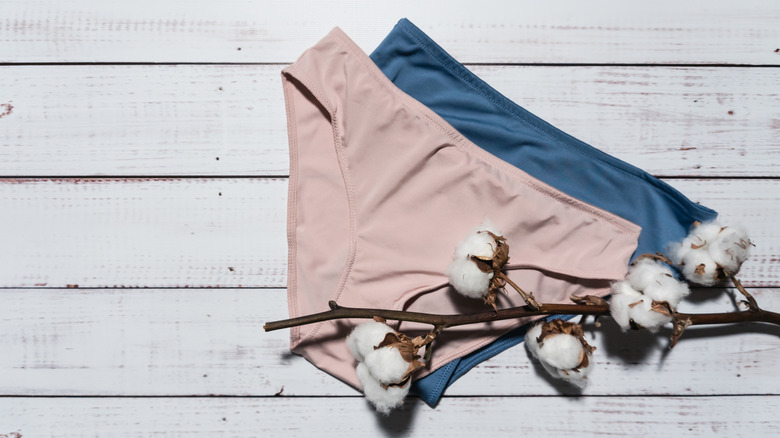Avoid Wearing These Types Of Clothing On Your Hiking Adventures For A Better Experience
We may receive a commission on purchases made from links.
Pinterest, Instagram, and TikTok are brimming with suggestions on how to piece together a fashionable hiking ensemble. Skintight leggings, distressed cotton T-shirts, and baseball caps are all on deck. However, choosing apparel in the vein of gorpcore fashion, as trendy as it may seem, will not always yield the most functional or comfortable experience on the trail. With the wrong clothing, you might come home from your hike with beautiful photos, but horrible memories of chafing, blisters, and sunburns.
For that reason, it is worth taking the time to delve into the details behind different clothing brands and products, then experimenting to discover what best suits your needs. Indeed, outdoor companies have spent years researching and producing clothing to combat chafing, regulate heat, protect consumers from UV rays, and increase hiker visibility. That means you have plenty of options from which to choose.
Finally, remember that hiking is one place where an upfront financial investment can reap long-term rewards. The last thing you want to be doing on the trail is stitching up a ripped seam or shivering in a poor-quality rain jacket. If you cannot afford to purchase high-quality clothing, see if you can rent or borrow from a friend. This is especially true in cold weather, where you will need to avoid the common clothing mistake hikers make by dressing in layers.
Cotton socks
Leave your favorite pair of punny socks at home for your next hike; odds are they are made of cotton. There's a good reason why entire companies — such as Darn Tough — have been founded to manufacture socks suitable for outdoor enthusiasts, including hikers. The cotton socks you wear daily are a surefire way to get blisters in wet conditions, whether it's due to a thunderstorm pelting down rain or a stream you have to step into to get to the other side of the trail. You already know the reason, too. Like cotton shirts and cotton underwear, cotton socks are not moisture-wicking. Plus, cheap cotton socks don't have the kind of ribbing required to keep socks in place. Their tendency to scrunch up or slouch can quickly lead to chafing.
Wool socks are generally kinder on the skin since they dry quickly and are adept at regulating heat. Lightweight, midweight, and heavyweight options are available on the market, with the best choice depending on weather conditions. Vegan alternatives to wool socks exist, too. For example, you might choose to wear Darn Tough's Coolmax® socks, which are made from materials like polyester, nylon, acrylic, and Lycra spandex. For additional protection, you can slip into a pair of liners before wearing your socks. Often made from synthetic materials, liners further limit the friction generated between your feet and shoes. Toe socks and toe liners, such as Injinji Liner Crew Toesocks, are ideal if you typically get blisters between your toes.
New shoes
You'll find plenty of opinions on the best kind of shoes to wear while hiking. Some folks swear by boots with ample ankle support, while others advocate for minimalistic shoes that mimic walking with bare feet. Not to mention, in many cultures, people are adept at hiking in sandals and prefer it that way (though most shoe companies would have you believe otherwise). So, rather than spend hours reading other people's opinions, stick to this one simple fact: You should never hike in new shoes.
No matter what, you should test a few pairs of shoes before hitting the trail. A professional fitting at an outdoor store can help identify shoe options based on the trails you plan to hike, and you might even leave with two pairs, each one suited to a different terrain. If you plan to hike a trail that is longer than a few miles, the final step is to spend time breaking in your shoes. This process can take just a few days for lightweight shoes or up to several weeks for heavy-duty boots.
Depending on the store, you might get a few days to try the shoes before committing to them long-term. This will allow you to test whether their outsoles have enough grip to sustain slippery conditions, how water-resistant or waterproof they are, whether their toe boxes will cause blisters, their level of ankle support, and if they feature enough ventilation. During this time, you can also experiment with different shoelace configurations that might help reduce aches, pains, and chafing. Even your favorite shoes may still cause blisters, so we suggest packing blister patches for long days on the trail. To wrap up the subject of shoes, consider this odd but easy hiking hack that could save your life.
Cotton T-shirts
Hiking in your favorite rock band T-shirt might make for a fashionable Instagram post, but it's certainly not the most comfortable or practical choice. As mentioned earlier, cotton does not adequately wick moisture away from the skin, so it can lead to chafing underneath the armpits where sweaty skin comes into contact with the fabric of your T-shirt. Plus, cotton T-shirts are a no-go when hiking in places like Patagonia, where potentially rainy conditions demand materials that dry quickly. Moisture-wicking shirts made from synthetic fabrics or merino wool promise a more pleasant hiking experience. In addition to preventing chafing, such materials can also help keep you cool and protected from the sun.
Polyester and nylon, two synthetic fabrics, star in many shirts designed for hiking because they do a fantastic job of wicking away moisture and keeping you cool. Meanwhile, merino wool is thinner than the wool found in a sweater and, therefore, perfectly suited as a base layer for hiking. Not only does merino wool have great elasticity, but it is also suitable for hot and cold conditions, is resistant to odors, and is even biodegradable. Shirts with built-in SPF protection are especially crucial when hiking in exposed environments (such as the deserts of the American Southwest). In such conditions, you might opt for a long-sleeved shirt for additional sun protection. Clothing made from merino wool usually features a UV Protection Factor (UPF) rating between 20 and 50. However, synthetic options, such as Willit Women's UPF 50+ Sun Protection Hoodie, can offer even more safety from UV rays.
Jewelry
The last thing you want to lose on the trail is your grandmother's silver bracelet or your precious diamond engagement ring. In addition to losing jewelry, there is always the risk that it can snag on branches or brambles when navigating tight spaces. Hairpieces in particular can get caught on overhead limbs when you are least expecting it, which is part of why wearing a hat is better than wearing bun sticks or hair clips while hiking.
Jewelry can also prove to be an uncomfortable fashion choice on the trail. In hot weather, your extremities may swell, making rings almost impossible to get off your fingers. Toe rings make no sense, either, as they almost guarantee chafing. Meanwhile, cold weather and wet conditions may cause your fingers to shrink, which brings us back to the risk of losing a ring on the trail.
Any time you go hiking, the best course of action is to leave all your jewelry at home. If your wrists feel naked, you can instead opt for a stylish athletic watch or a set of Soulvation Boho Hair Tie Bracelets. Functional is fashionable in the great outdoors, so don't be fooled by influencers' photographs on social media. Hiking with dangly earrings and a dozen bangles on each arm is not the norm.
Cheap sunglasses
The plastic sunglasses you got for free at a corporate event are likely not the best choice for hiking. Instead, invest in a pair of sunglasses with high ultraviolet (UV) protection and low visible light transmission (VLT). This goes for all seasons; after all, any skier or snowboarder can confirm that snow does an excellent job of reflecting light and UV rays onto our faces. Importantly, UV protection and VLT are not synonymous; the former deals with invisible UV rays while the latter regards visible light. As a result, you can't tell how much UV protection a pair of sunglasses offers simply by putting them on your face, but you can get a pretty good idea of how much light they block.
First, make sure that your sunglasses filter out 98% to 100% of UV radiation. Then, depending on the conditions, confirm that they feature either Category 3 or 4 lenses. Category 3 lenses have a dark tint and offer adequate protection in sunny conditions. On the other hand, Category 4 lenses have a very dark tint and are recommended for hikes with stronger sunrays and high glare. This includes exposed trails in the desert or in the mountains, where snow goggles may also be useful. You may see these terms shortened to "Cat 3" and "Cat 4," respectively.
Of course, you won't be wearing your sunglasses 24/7. You'll need to take them off to snap photos, see clearly on shady sections of the trail, and see at night once dusk settles in. Hook your sunglasses onto Croakies to make taking them on and off easier.
Jeans
You may like how denim looks, but save the jeans for your next day in town because they will certainly chafe you during a long hike. After all, denim is simply cotton that has been woven with yarn, and its texture can be rough, especially when it's new. Plus, jeans cannot hold their own in extreme weather conditions. In hot weather, jeans will only make you sweat even more profusely, and in cold weather, they are far from the best insulators. And it doesn't take much imagination to conceive what hiking in jeans would be like in rainy weather; they might take days to dry. Even just a splash in a puddle can lead to an uncomfortable hike. Finally, jeans typically do not provide much mobility, so if you need to scramble over rocks, a stretchier pair of pants would be a wise choice.
Instead of jeans, opt for shorts, a skort, or hiking pants. Just keep in mind that even these alternatives come with a risk of chafing, depending on the brand, your body type, and the weather conditions. It's always a good idea to apply a lubricant to the skin to reduce chafing, such as Body Glide Outdoor Anti-Chafe Balm, and to favor moisture-wicking fabrics like spandex.
Dull colors
Dull colors are a no-go for folks who hike in hunting areas. Bright colors help make your presence known to those with firearms, and on some trails, you might even find signs advising you to wear a blaze orange vest during hunting season. While we're on the topic, consider leaving your dog at home during this time of year, or attach a bell to their collar and keep them on a leash at all times. Additional precautions include making noise (such as talking, singing, or whistling) and hiking during bright daylight. Finally, bright colors not only protect you from hunters, but they also enable you to hunt down disease-carrying ticks. You want to go home with memories of stunning scenery and life-affirming climbs — not Lyme disease.
Wearing bright colors on high-risk trails can also help emergency responders find you in case of an accident. You may be the most well-equipped and savvy hiker in the world, but at the end of the day, you are still at the mercy of nature. Choose hues that are easily distinguishable from the environment where you will be hiking, and keep this color scheme in mind for equipment as well. If you love '80s fashion, then you are in luck; you can buy everything from a fanny pack to a tent in neon colors.
Clothing with major seams
If you have ever taken off a sports bra or pair of underwear and seen its outline traced in red on your skin, then you already know that chafing frequently occurs where there are major seams in clothing. That's because friction is higher in these areas, which also explains why bras with clasps and underwires can be a nightmare while hiking. Thankfully, hiking today is far more comfortable than it was 50 years ago, since the technology used in manufacturing clothing has evolved significantly to make sustained movement gentler on the skin. This has been demonstrated beautifully by the rise in seamless clothing, a method where fabrics are joined together using heat or ultrasonic waves. Today, seamless clothing is bountiful, and investing in seamless underwear, bras, leggings, and hiking shirts is a wise move if you want to limit those pesky red rashes.
Not every garment can be manufactured using the seamless method, however. The buttons and zippers inherent to the designs of many hiking garments often require stitches. That's where flatlock seams come into play. As opposed to a traditional seam, which leaves a flap of fabric inside a garment, a flatlock seam is flat on both sides. Base layers, especially synthetic ones, often feature flatlock seams, as do heftier garments like fleece jackets. Because merino wool is typically considered a softer material with a lower risk of chafing, you may see both styles of seams applied to this fabric.
Cotton underwear
Many hikers choose to go commando while hiking, whether for the sake of comfort or lighten load (every ounce counts for ultralight backpackers). Ditching underwear also makes sense if you are wearing skirts or shorts with built-in liners. However, if you choose to wear underwear, you should avoid cotton at all costs. That's because cotton is neither moisture-wicking nor particularly breathable. If you are through-hiking a trail, you should also note that cotton is not as durable as synthetic fabrics, so it might not be long before you find holes in your undergarments.
Compared to cotton, alternative materials like polyester, nylon, and merino wool make for better hiking underwear. If you're looking for quick-drying and durable underwear, opt for synthetic fabrics. If you want to mitigate odor from sweat, choose merino wool. Finally, flatlock seams or seam-free underwear can offer additional comfort during those long hours spent on the trail. They help reduce the amount of friction rubbing against your skin and can therefore be what stands between you and painful red rashes.
If you are embarking on an overnight or multi-day trip, changing and choosing the right underwear is critical for proper hygiene. Pack at least one pair per day, and wash each one thoroughly before wearing it again. One of our top recommendations is ExOfficio's Give-n-Go Sport Underwear, which has both men's and women's variations. Make sure to purchase a size that fits snugly and comfortably.
Baseball caps
Including a hat is a great start when piecing together your trail ensemble, but you need to make sure it is the right one. Here's a hint: While baseball caps look cool, they aren't the most functional choice for the trail. If you plan to hike in exposed conditions, opt for a hat with a 360-degree brim. Otherwise, the back of your neck will not be protected from UV rays, and you might end up with intense sunburns.
Bucket hats are great, as are hats with even wider brims and flaps of fabric that hang down the back of the neck. Even balaclavas can help protect you from the sun and are especially ideal in cold conditions. Next, if there is even a small chance of a breeze, choose a hat with a chin strap so it doesn't fly into a canyon or over a cliff. Finally, moisture-wicking hats, hats with ventilation features, and hats with SPF protection bring your hiking game to a whole new level. You may look like you are going on a safari, but it will be worth it for the extra comfort you feel during and after your trek.
